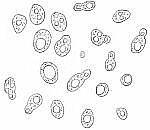The changes undergone by frozen goods are time- and temperature-dependent: the lower the temperature, the longer the storage life and the lesser the changes in color, flavor, odor and vitamin content.
The temperature range between freezing point and approx. -12°C is avoided because, due to the still elevated unfrozen water content, the goods may suffer serious degradation in quality due to the possible microbiological and enzymatic changes and changes in freezing and consistency. An uninterrupted freezing chain must be ensured with frozen goods too in order to avoid any disadvantageous changes in the frozen goods such as recrystallization due to the temperature fluctuations caused by transient thawing.
The following is an example of an incident of loss:
Strawberries for making jam were to be shipped from Poland to Germany in plastic barrels.
The strawberries were precooled to a temperature of 0°C in 220 plastic barrels, each holding 95 kg. The truck body was cooled to -20°C.
On arrival in Germany (7 days later) the strawberries exhibited a fruit juice-like fermented odor and a fermented flavor. The juice was foaming as a result of the fermentation processes.
Due to their low mechanical strength, strawberries are classed as soft fruit and, due to their high water content (90%) are particularly susceptible to molds and yeasts. Grey mold rot (Botrytris cinerea, see Fig. 98), wet rot (caused by the Mucorales fungus Rhizopus nigricans, see Fig. 99) and yeasts (Saccharomyces cerevisiae, see Fig. 100) may cause the strawberries to ferment.
The truck's refrigeration unit was only capable of maintaining a certain precooled temperature below freezing, but was not able to cool down a "warm" load. The strawberries ought to have been rapidly frozen to -20°C before transport.
 |
 |
| Figure 98: Grey mold (Botrytis cinerea), which causes grey mold rot |
Figure 99: The mold Rhizopus nigricans, which causes wet rot 1 - sporangium 2 - burst sporangium 3 - sporangiophore with high plasma content 4 - rhizoids |
 |
Figure 100: The yeast Saccharomyces cerevisiae |
At a precooling temperature of only 0°C, sufficient cell water was still in the liquid state for molds, yeasts and enzymes to be able to cause the cytosol to ferment.
Moreover, the exclusion of oxygen may have resulted in anaerobic respiration of the strawberries. The same situation can also arise in containers as they are not suitable for freezing goods.